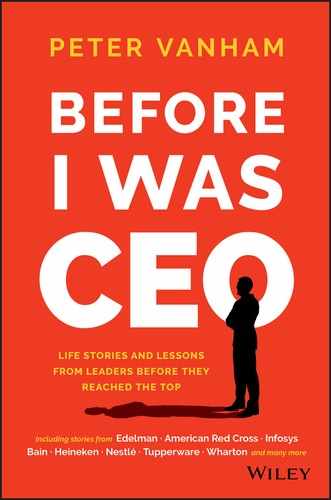Foreword
LEARNING TO LEAD FROM THOSE WHO HAVE LED
How do you become a chief executive officer?
It is a great question and one that never grows old. Aspiring managers have no doubt wondered about it since the office of the CEO was invented, and it recurrently inspires stories in the business press. Students in my MBA classes are perennially curious, as are managers in our executive programs and participants in our leadership conferences.
Intellectual curiosity drives some of the attention, just as we might be naturally interested in how an individual became a concert pianist or a news anchor. But, I think pragmatic inquisitiveness drives more of the attentiveness. If managers can learn the personal pathways from those who have arrived at the top, they might find a proven roadmap for doing so as well. For those like myself who offer learning programs on leadership, CEOs looking back can also throw light on one of most vexing but also most vital career questions of all: how exactly does one learn to lead?
Peter Vanham's Before I Was CEO offers just that, a lifting of the curtains on the personal itineraries of twenty diverse CEOs. Some are American; others are from Belgium, India, and beyond. The accounts are firsthand and in-depth. Peter visited with each of the chief executives featured in his book, and he came to know them in their homes, at their offices, and on their travels. He followed them around the world, from Amsterdam to Washington, Dubai to Davos. From his lengthy sit-down interviews comes a unique set of accounts, deeply personal and compellingly instructive.
For some of the featured CEOs, including Patrick De Maeseneire of Adecco Group, the world's largest staffing organization, and Gail McGovern of the American Red Cross, the pathway was a very methodical one. With the final goal clearly in mind, they foresaw the roles required to master the craft of ever more responsible general management. They took them one step at a time with their progressive mastery much in mind.
For other CEOs, their way up was more a story of serendipity. They happened to be the right person at the right time, or a fortuitous connection proved providential, or they were just doing what they loved to do when they were tapped to take charge of more and more of it. While these pathways are less subject to design, they still call for the adage of scientist Louis Pasteur, “chance favors the prepared mind,” or Facebook's Sheryl Sandberg's “fortune favors the bold.” There is no predictable way to the apex but, when fortune strikes, being prepared and being bold can be critical, making the most of what you can't control.
Still others report the power of a seminal figure, a teacher or a mentor or a boss who proved pivotal. When Kris Gopalakrishnan, for instance, had failed an entry exam to study medicine, a college teacher picked him up, restored his equanimity, and moved him on a path that would eventually carry him to the corner office of the preeminent Indian outsourcing company, Infosys.
For all the diverse tracks, two common threads stand out. First, a majority of the CEOs spent long periods of time abroad, far from the headquarters. While being out of sight can conjure fears of being out of mind, the international experience more than made up for the home office absence, an essential credential for an era when virtually all major organizations are globalizing.
Second, many of the CEOs have sustained a vibrant family life along with their demanding professional life. The stereotype of the driven workaholic with too little time for the second half of the work–life balance was simply not found among our CEOs. And, from their journeys, we are also reminded of the life well lived: discover and develop your passion, find a career line that calls upon it, take time to meet the right life partner, and invest in that lifetime together.
The chief executives also prompt us to keep the present engagement just as much in mind as the final goal. Savor the present, they say, enjoying the journey as much as the destination. This is one of the lessons learned from Paul Bulcke, CEO of Nestlé, the world's largest food and beverage company, headquartered in Vevey, Switzerland. He reported that he had spent more than a decade in the turbulent markets of Latin America in the 1980s. Crime was rampant, economic growth volatile, and inflation out of control, yet he reported savoring every day's working challenges. For many years he was off the radar of his bosses in Vevey, and he was not thinking about one day becoming chief executive. But he became widely recognized for being a dedicated company manager who could achieve results even in the harshest of circumstances.
Before I Was CEO is filled with these and a host of other insights into the market forces and personal decisions that helped elevate the managers into high office. No two pathways to the apex are identical, and no single pathway is a sure way to get there. But in hearing directly from those at the top, so well chronicled by Peter Vanham, we are all better informed for both our intellectual understanding of these pathways and our pragmatic appreciation for what has propelled their travelers to the top.
Michael Useem
Wharton School, University of Pennsylvania
